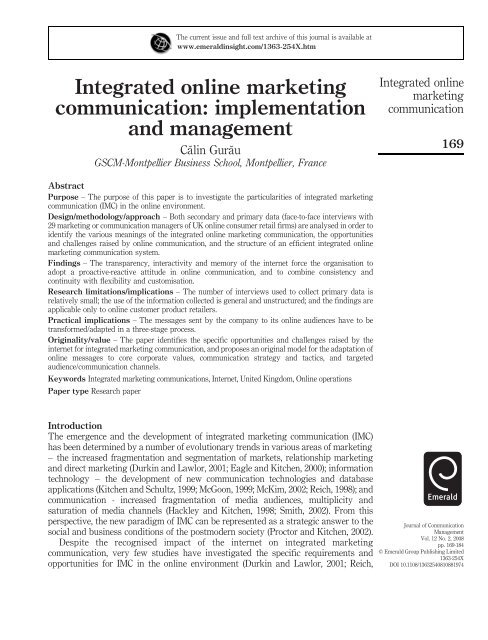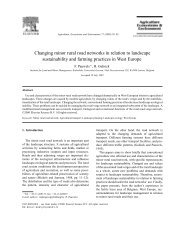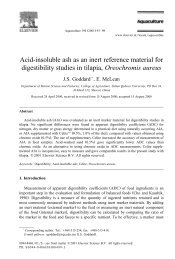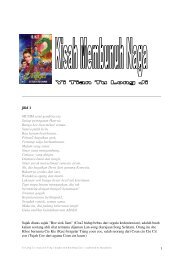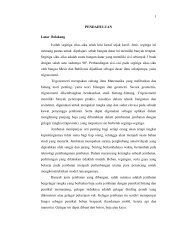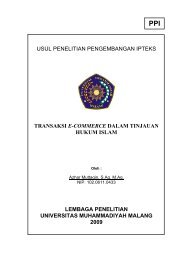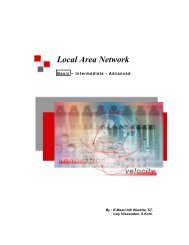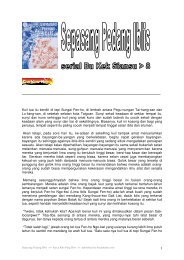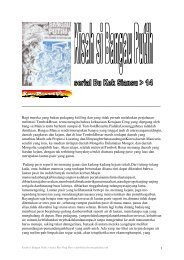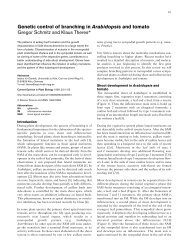Integrated online marketing communication ... - Directory UMM
Integrated online marketing communication ... - Directory UMM
Integrated online marketing communication ... - Directory UMM
Create successful ePaper yourself
Turn your PDF publications into a flip-book with our unique Google optimized e-Paper software.
The current issue and full text archive of this journal is available at<br />
www.emeraldinsight.com/1363-254X.htm<br />
<strong>Integrated</strong> <strong>online</strong> <strong>marketing</strong><br />
<strong>communication</strong>: implementation<br />
and management<br />
Călin Gurău<br />
GSCM-Montpellier Business School, Montpellier, France<br />
Abstract<br />
Purpose – The purpose of this paper is to investigate the particularities of integrated <strong>marketing</strong><br />
<strong>communication</strong> (IMC) in the <strong>online</strong> environment.<br />
Design/methodology/approach – Both secondary and primary data (face-to-face interviews with<br />
29 <strong>marketing</strong> or <strong>communication</strong> managers of UK <strong>online</strong> consumer retail firms) are analysed in order to<br />
identify the various meanings of the integrated <strong>online</strong> <strong>marketing</strong> <strong>communication</strong>, the opportunities<br />
and challenges raised by <strong>online</strong> <strong>communication</strong>, and the structure of an efficient integrated <strong>online</strong><br />
<strong>marketing</strong> <strong>communication</strong> system.<br />
Findings – The transparency, interactivity and memory of the internet force the organisation to<br />
adopt a proactive-reactive attitude in <strong>online</strong> <strong>communication</strong>, and to combine consistency and<br />
continuity with flexibility and customisation.<br />
Research limitations/implications – The number of interviews used to collect primary data is<br />
relatively small; the use of the information collected is general and unstructured; and the findings are<br />
applicable only to <strong>online</strong> customer product retailers.<br />
Practical implications – The messages sent by the company to its <strong>online</strong> audiences have to be<br />
transformed/adapted in a three-stage process.<br />
Originality/value – The paper identifies the specific opportunities and challenges raised by the<br />
internet for integrated <strong>marketing</strong> <strong>communication</strong>, and proposes an original model for the adaptation of<br />
<strong>online</strong> messages to core corporate values, <strong>communication</strong> strategy and tactics, and targeted<br />
audience/<strong>communication</strong> channels.<br />
Keywords <strong>Integrated</strong> <strong>marketing</strong> <strong>communication</strong>s, Internet, United Kingdom, Online operations<br />
Paper type Research paper<br />
Introduction<br />
The emergence and the development of integrated <strong>marketing</strong> <strong>communication</strong> (IMC)<br />
has been determined by a number of evolutionary trends in various areas of <strong>marketing</strong><br />
– the increased fragmentation and segmentation of markets, relationship <strong>marketing</strong><br />
and direct <strong>marketing</strong> (Durkin and Lawlor, 2001; Eagle and Kitchen, 2000); information<br />
technology – the development of new <strong>communication</strong> technologies and database<br />
applications (Kitchen and Schultz, 1999; McGoon, 1999; McKim, 2002; Reich, 1998); and<br />
<strong>communication</strong> - increased fragmentation of media audiences, multiplicity and<br />
saturation of media channels (Hackley and Kitchen, 1998; Smith, 2002). From this<br />
perspective, the new paradigm of IMC can be represented as a strategic answer to the<br />
social and business conditions of the postmodern society (Proctor and Kitchen, 2002).<br />
Despite the recognised impact of the internet on integrated <strong>marketing</strong><br />
<strong>communication</strong>, very few studies have investigated the specific requirements and<br />
opportunities for IMC in the <strong>online</strong> environment (Durkin and Lawlor, 2001; Reich,<br />
<strong>Integrated</strong> <strong>online</strong><br />
<strong>marketing</strong><br />
<strong>communication</strong><br />
169<br />
Journal of Communication<br />
Management<br />
Vol. 12 No. 2, 2008<br />
pp. 169-184<br />
q Emerald Group Publishing Limited<br />
1363-254X<br />
DOI 10.1108/13632540810881974
JCOM<br />
12,2<br />
170<br />
1998), and the relation between IMC and customer relationship management<br />
(Grönroos, 2004; Johnson and Schultz, 2004; Schultz, 2003).<br />
The present paper attempts to investigate the particularities of implementing IMC<br />
in an <strong>online</strong> environment. The study starts from the premise that the specific<br />
characteristics of the internet transform the application of IMC principles from an<br />
alternative option to an absolute requirement (Schultz, 1996). Based on an analysis of<br />
the specific characteristics of the <strong>online</strong> environment and audiences, and on the<br />
primary data collected through face-to-face interviews with 29 <strong>marketing</strong> or<br />
<strong>communication</strong> managers of UK consumer retail firms, the meanings of the<br />
integrated <strong>marketing</strong> <strong>communication</strong> in the <strong>online</strong> environment, as well as the<br />
challenges and the opportunities created by the internet for the implementation of an<br />
<strong>online</strong> IMC process, are identified and discussed. The contrastive elements of the<br />
integrated <strong>online</strong> <strong>marketing</strong> <strong>communication</strong> are then synthesised in a theoretical model<br />
that can be adopted by internet-active business organisations.<br />
<strong>Integrated</strong> <strong>marketing</strong> <strong>communication</strong> – the evolution of a concept<br />
The IMC approach has received almost instant recognition at the end of the 1990s, as a<br />
result of the existing trends to reduce the budget allocated to mass advertising<br />
campaigns and to concentrate on segmented or personalised <strong>communication</strong> with final<br />
consumers (Durkin and Lawlor, 2001; Eagle and Kitchen, 2000). The increased<br />
fragmentation of media and customers, as well as the revolution introduced in mass<br />
<strong>communication</strong> by the new <strong>communication</strong> channels – internet and mobile<br />
<strong>communication</strong> technologies – has created the need for a new approach to<br />
<strong>marketing</strong> <strong>communication</strong>, that can insure centralised management and a consistency<br />
of corporate messages sent towards various audiences (McArthur and Griffin, 1997;<br />
Semenik, 2002; Smith, 2002).<br />
A series of articles written between 1991 and 1996 have outlined the specific<br />
dimensions of the IMC concept, presenting it as a logical answer to the problems<br />
experienced by many business and non-profit organisations (Miller and Rose, 1994;<br />
Moriarty, 1994; Novak et al. 1996; Rose, 1996; Schultz, 1991, 1993a, 1993b; 1996).<br />
Following this phase in which the concept has received the proper legitimacy, a series<br />
of studies (Kitchen and Schultz, 1997; 1998; 1999) have initiated an investigation into<br />
the practical application of the concept by the practitioners – especially US and<br />
UK-based advertising agencies. The conclusions of these studies were complex: on one<br />
hand, the advertising executives recognised the impact of IMC on increasing the<br />
effectiveness of creative ideas, providing greater <strong>communication</strong> consistency, and<br />
improving the client return on investment; on the other hand, they outlined the<br />
problems related with measuring the IMC outcomes in terms of time and cost<br />
efficiencies (Kitchen et al., 2004).<br />
The further development of the IMC theory was a horizontal one, the concept being<br />
associated with various areas of corporate <strong>communication</strong>s: management and<br />
branding (Fill, 2002), customer and stakeholders relationships (Duncan, 2002), global<br />
branding and localised <strong>communication</strong> (Kanso and Nelson, 2002). At the same time, a<br />
series of authors criticised the IMC lack of theoretical foundation (Cornelissen and<br />
Lock, 2000), or the real applicability of the concept (Percy et al., 2001).<br />
The concept of IMC was defined in many different, often contradictory, ways<br />
(Duncan, 2002; Kitchen, 1999; Kliatchko, 2008; Schultz et al., 1993; Smith et al., 1997;
Shimp, 2000). The integration of <strong>marketing</strong> <strong>communication</strong> procedures was considered<br />
a result of centralised management, centralised budgeting, or message similarity<br />
across all <strong>communication</strong> channels.<br />
According to Pickton and Broderick (2001), <strong>marketing</strong> <strong>communication</strong>s tools that<br />
were traditionally separated and specialised in “above the line” and “below-the-line”<br />
activities, should be now integrated under the IMC concept. Pickton and Broderick<br />
(2001) claim that synergy is the principal benefit of bringing together the various facets<br />
of <strong>marketing</strong> <strong>communication</strong>s in a mutually supportive way. From this perspective,<br />
<strong>marketing</strong> <strong>communication</strong> decisions should focus on the <strong>marketing</strong> <strong>communication</strong>s<br />
channel that offers the highest benefit for all the stakeholders. The focus of this<br />
definition is still very much on <strong>communication</strong> functions (tactics) rather than on the<br />
broad view of establishing close relationships to multiple stakeholders.<br />
Other definitions emphasise that the integration of <strong>marketing</strong> <strong>communication</strong><br />
should not be understood as a simple uniformity of the message transmitted across<br />
different channels (Kitchen et al., 2004), but rather as the complex coordination and<br />
management of the information transmitted though complementary channels in order<br />
to effectively present a coherent image of the organisation to the targeted audiences. A<br />
good example is the definition proposed by Keegan et al. (1992, p. 631):<br />
<strong>Integrated</strong> <strong>marketing</strong> <strong>communication</strong>s is the strategic co-ordination of all messages and<br />
media used by an organisation to collectively influence its perceived brand value.<br />
This definition focuses on the concept of “strategic co-ordination”, indicating the<br />
evolution from tactical coordination towards a more strategic approach, in order to<br />
realise <strong>communication</strong> synergies. In addition, the definition considers “all messages”<br />
highlighting that both internal and external activities contribute to <strong>marketing</strong><br />
<strong>communication</strong>s efforts, and stresses the focus on brand value that requires a change<br />
of <strong>marketing</strong> and <strong>communication</strong> perspective. At the heart of this definition is the<br />
assumption that the credibility and value of both the company and its brand(s) will<br />
increase, when messages transmitted to various audiences become consistent across<br />
time and targets.<br />
Another definition proposed by Duncan (2002, p. 8) demonstrates the current<br />
conceptual perception of IMC:<br />
A cross-functional process for creating and nourishing profitable relationships with<br />
customers and other stakeholders by strategically controlling or influencing all messages<br />
sent to these groups and encouraging data-driven, purposeful dialogue with them.<br />
An important contribution of this definition is the emphasis on “profitable<br />
relationships”.<br />
Moreover, Duncan acknowledges that integrated <strong>marketing</strong> <strong>communication</strong>s<br />
involves a cross-functional process. This indicates that all organisational departments<br />
that interact with customers and strategic stakeholders must share a common<br />
understanding and work collectively to develop long-term brand relationships.<br />
Furthermore, the notion of stakeholders implies the shift in the IMC concept from<br />
customer target audiences to the inclusion of key stakeholder groups such as<br />
employees, investors, suppliers, distributors, media and the social community.<br />
Conceptually, IMC provides an opportunity for organisations to enhance the<br />
relationship of their brands with customers and other stakeholders (Beverland and<br />
Luxton, 2005). The strategic co-ordination of all <strong>marketing</strong> and <strong>communication</strong> tools<br />
<strong>Integrated</strong> <strong>online</strong><br />
<strong>marketing</strong><br />
<strong>communication</strong><br />
171
JCOM<br />
12,2<br />
172<br />
can lead to a consistent brand message directed towards the targeted audiences, using<br />
effective media planning. This strategy fosters an ongoing consumer-brand<br />
relationship dialogue whilst also generating enhanced consumer appeal.<br />
Despite the recognised importance of implementing integrated <strong>marketing</strong><br />
<strong>communication</strong> procedures, the organisational structure of many companies<br />
prevents or restricts its effective implementation. In reality, IMC does not fit easily<br />
into the organisational structure adopted by most firms. Percy (1997) argues that the<br />
theory of IMC, while theoretically pragmatic, ultimately fails because of significant<br />
structural barriers to its implementation. The most significant organisation barriers<br />
for the implementation of the IMC concept are:<br />
. lack of horizontal <strong>communication</strong>;<br />
. functional specialisation;<br />
. decentralisation;<br />
. lack of IMC planning and expertise;<br />
. lack of budget;<br />
. lack of database technology;<br />
. corporate culture; and<br />
. fear of change.<br />
These barriers must be assessed and properly understood in order to facilitate IMC<br />
implementation within an organisation. However, each corporation has different<br />
<strong>marketing</strong> <strong>communication</strong>s structures already in place and must deal with a distinctive<br />
organisational culture that is embodied in an individual organisational design.<br />
Consequently, it is impossible to design an implementation model that generally fits all<br />
firms. The in-depth analysis of each organisation will provide a specific combination of<br />
barriers and possible synergies, that have to taken into account when planning and<br />
implementing the IMC concept. On the other hand, more research it is necessary, both<br />
at theoretical and at practical level, to refine the definition and the modelisation of IMC,<br />
and to identify the best ways of integrating the <strong>marketing</strong> <strong>communication</strong> operations<br />
in specific corporate environments (Gould, 2004; Schultz and Kitchen, 2000a, b).<br />
Research methodology<br />
In order to analyse the importance and the role of integrated <strong>marketing</strong> <strong>communication</strong><br />
for internet-active organisations, the following research objectives have been<br />
formulated:<br />
. To analyse the general impact of internet technology on the <strong>marketing</strong><br />
<strong>communication</strong> process and the behaviour of audiences.<br />
. To define the meaning/s of integrated <strong>online</strong> <strong>marketing</strong> <strong>communication</strong>.<br />
. To identify the <strong>marketing</strong> <strong>communication</strong> synergies allowed by the internet.<br />
. To identify the challenges raised by the internet for the integrated<br />
<strong>communication</strong> process.<br />
. To design a synthetic model describing the structure and functioning of an<br />
integrated <strong>online</strong> <strong>marketing</strong> <strong>communication</strong> system.
A series of secondary sources of data have been accessed in the first instance, in order<br />
to collect general information about the evolution of the IMC concept, internet<br />
characteristics, <strong>online</strong> <strong>communication</strong> and <strong>online</strong> audiences.<br />
In the second stage of data collection, a series of semi-structured interviews have<br />
been conducted with <strong>marketing</strong> or <strong>communication</strong> managers of internet-active UK<br />
retailing firms. Using the contact information provided on their web sites, 70 UK<br />
retailers specialised in consumer products (food, drinks, cosmetics, clothes, shoes) have<br />
been contacted by phone or by email, and invited to participate in this study. 34 of<br />
these firms have responded favourably, but only 29 interviews could be organised<br />
because of time restrictions in the interviewees’ programme. The face-to-face<br />
interviews took place during February-May 2005, and lasted between 40 and 60<br />
minutes. The topics of discussion included the concept of integrated <strong>marketing</strong><br />
<strong>communication</strong>, the opportunities and challenges created by the internet concerning<br />
the corporate <strong>communication</strong> model, and the specific strategic model that can enhance<br />
the <strong>online</strong> <strong>marketing</strong> <strong>communication</strong> process. This methodological approach attempts<br />
to implement in practice the recommendation of Kitchen and Schultz (1999) to<br />
investigate and analyse the reaction of various practitioners to the IMC concept.<br />
The analysis of the primary data was made manually, considering the limited<br />
number of interviews performed and the exploratory nature of the study.<br />
The impact of the internet technology on <strong>marketing</strong> <strong>communication</strong><br />
The rapid development of the internet in the last ten years has changed the classical<br />
<strong>communication</strong> procedures (Blattberg and Deighton, 1991; Holtz, 1999), because of<br />
three specific and co-existent characteristics that differentiate it from any other<br />
<strong>communication</strong> channel:<br />
. Interactivity. The internet offers multiple possibilities of interactive<br />
<strong>communication</strong>, acting not only as an interface, but also as a <strong>communication</strong><br />
agent (allowing a direct interaction between individuals and software<br />
applications).<br />
. Transparency. The information published <strong>online</strong> can be accessed and viewed by<br />
any internet user, unless this information is specifically protected.<br />
. Memory. The web is a channel not only for transmitting information, but also for<br />
storing information – in other words, the information published on the web<br />
remains in the memory of the network until it is erased.<br />
These options are transforming the profile and the behaviour of <strong>online</strong> audiences.<br />
Marketing <strong>communication</strong> practitioners should therefore adapt to the new realities of<br />
how audiences get and use information:<br />
. The audience is connected to the organisations. The traditional <strong>communication</strong><br />
channel was uni-directional – the institutions communicated and the audiences<br />
consumed the information. Even when <strong>communication</strong> was considered a<br />
two-way process, the institutions had the resources to send information to<br />
audiences through a very wide pipeline, while the audiences had only a<br />
minuscule pipeline for communicating back to the institutions (Ihator, 2001).<br />
Now, the <strong>communication</strong> channel is a network, not a pipeline. This network has<br />
closed the gap between institution and audience. Everybody involved in sending<br />
<strong>Integrated</strong> <strong>online</strong><br />
<strong>marketing</strong><br />
<strong>communication</strong><br />
173
JCOM<br />
12,2<br />
174<br />
the message – the company, its CEO, its <strong>communication</strong> manager, the external<br />
<strong>communication</strong> agency – are only one click away from the audience. To some<br />
extent, communicators have grasped and even embraced this new proximity,<br />
fact demonstrated by the vast number of web sites which display “Contact Us”<br />
buttons and links (Blattberg and Deighton, 1991). However, in most of the cases,<br />
these new facilities are not fully used. The ease of <strong>communication</strong> has led to an<br />
exponential increase in the number of incoming messages, but many<br />
organisations have not increased the resources needed to deal with them. In<br />
the new model, communicators must engage members of the audience on a<br />
one-to-one basis (Holtz, 1999).<br />
. The audience is connected to one another. Considering the nature of the network,<br />
if the audience is one click away from the institution, it is also one click away<br />
from other members of the audience. Today, a company’s activity can be<br />
discussed and debated over the internet, without the knowledge of that<br />
organisation. In the new environment everybody is a communicator, and the<br />
institution is just part of the network (Shankar and Malthouse, 2007).<br />
. The audience has access to other information. In the past, because of the slowness<br />
and difficulty to access specific information, the communicator was able to make<br />
a statement with the reasonable certainty that it would be impossible for the<br />
average audience member to challenge it. Today, it is easy to access multiple<br />
sources of information over the internet. Any statement made can be dissected,<br />
analysed, discussed and challenged within hours by interested individuals.<br />
. Audiences pull information. The networked world has increased exponentially<br />
the number of available channels of <strong>communication</strong> (Holtz, 1999). Today, we get<br />
messages from multiple media channels: email, voice mail, faxes, pagers, cell<br />
phones, interoffice memos, overnight courier packages, television (with hundreds<br />
of channels), radio, internet radio, etc. As a result, the media that used to provide<br />
an efficient channel of <strong>communication</strong> for practitioners have become now only<br />
noise that most of the audiences have learned to filter out. On the other hand, the<br />
networked environment provided the audiences with a new model, one in which<br />
they no longer accept every message a communicator wants to push to them, but<br />
they rather pull the information that suits their interests and needs. In the<br />
networked environment, information has to be available where audiences can<br />
find it, and must be customized or customizable (Rowley, 2001, 2004).<br />
Therefore, in comparison with the traditional customer, the internet user has more<br />
control over the <strong>communication</strong> process, and can adopt a more proactive attitude,<br />
expressed by the capacity to:<br />
. easily search, select and access information (using search and meta-search<br />
engines, intelligent agents, etc.);<br />
. contact <strong>online</strong> organisations or other individuals (using email, chat or discussion<br />
forms); and<br />
. express their opinions/views in a visible and lasting manner (creating and<br />
storing <strong>online</strong> content).
Taking advantage of the various <strong>online</strong> resources requires strategic thinking that<br />
recognizes that all these aspects of the networked world coexist. They must be<br />
coordinated to achieve specific, measurable objectives consistent with the goals of any<br />
<strong>marketing</strong> <strong>communication</strong> effort.<br />
The meaning/s of integrated <strong>online</strong> <strong>marketing</strong> <strong>communication</strong><br />
Many studies have emphasised the lack of a unifying definition for integrated<br />
<strong>marketing</strong> <strong>communication</strong>. One possible explanation of this theoretical crisis is the<br />
multitude of possible co-existent meanings for the IMC concept (Lee and Park, 2007).<br />
This assumption might also be true in the case of internet <strong>communication</strong>.<br />
In order to identify the meaning/s of integrated <strong>online</strong> <strong>marketing</strong> <strong>communication</strong>,<br />
the interviewees have been asked to freely express the issues related with this concept<br />
in their practical activity. The responses have been semantically analysed and the<br />
following categories of meaning have been identified (see Table I).<br />
As it can be seen, for all respondents, the integrated <strong>online</strong> <strong>marketing</strong><br />
<strong>communication</strong> represents a multi-faceted phenomenon, which comprises issues<br />
related with the message, the <strong>communication</strong> function, the management of<br />
information, and the specific mix of channels used for corporate <strong>communication</strong>. On<br />
the basis of these answers, the synergies and the challenges raised by the internet are<br />
discussed in more detail in the following two sections.<br />
Internet-based <strong>communication</strong> synergies<br />
Internet technologies allow <strong>online</strong>-active organisations to implement three main<br />
<strong>communication</strong> synergies:<br />
(1) The integration and coordination of <strong>communication</strong> modes (Hoffman et al.,<br />
1995): the organisations can combine one-to-one (email), one-to-many<br />
(list-based email messages, web pages), and many-to-many (discussion<br />
forums) <strong>communication</strong> in the <strong>online</strong> environment. This synergy increases<br />
Meaning Frequency Percentage<br />
Combination of <strong>communication</strong> modes (one-to-one, one-to-many,<br />
many-to-many) 29 100<br />
Integration of information types (text, sound, image) 27 93.1<br />
Consistency of messages transmitted trough the <strong>online</strong><br />
<strong>communication</strong>-mix (coherent meaning) 29 100<br />
Integration of <strong>marketing</strong> and PR <strong>communication</strong> functions in<br />
the messages provided <strong>online</strong> 29 100<br />
The coordination of the process: message conception –<br />
transmission – feedback reception and analysis, in a closed loop 17 58.6<br />
The direct connection of the corporate information system with<br />
the internet 18 62<br />
Coordination of internal, external and internal-external flows of<br />
information 19 65.5<br />
The integration of <strong>online</strong> <strong>marketing</strong> <strong>communication</strong> with the<br />
<strong>communication</strong> conducted through traditional channels 24 82.8<br />
The consistency of the corporate message at<br />
global/international level 14 48.3<br />
<strong>Integrated</strong> <strong>online</strong><br />
<strong>marketing</strong><br />
<strong>communication</strong><br />
175<br />
Table I.<br />
The practical meanings<br />
of integrated <strong>online</strong><br />
<strong>marketing</strong><br />
<strong>communication</strong>
JCOM<br />
12,2<br />
176<br />
the flexibility of the integrated <strong>communication</strong> approach, providing<br />
opportunities both for the personalisation and integration of messages<br />
(Rowley, 2001, 2004). One respondent has outlined that:<br />
...the corporate web site represents a common platform for various <strong>communication</strong><br />
tools and procedures. This represents both an opportunity and a challenge for<br />
integrated <strong>marketing</strong> <strong>communication</strong>. On one hand, this is forcing us to consider the<br />
interaction and the synergy among various <strong>communication</strong> procedures, but on the<br />
other hand, creates problems in terms of segmenting and addressing the needs of<br />
various audiences.<br />
(2) The integration and coordination of various types of information (Azzone et al.,<br />
2000): the recent advances in information and <strong>communication</strong> technologies<br />
(broadband) allow organisations to transmit or receive a complex combination<br />
of information in the form of texts, sounds and images (static and/or dynamic).<br />
This synergy has a direct effect on the complexity and clarity of the<br />
<strong>communication</strong>, enhancing the capacity of the organisation to tailor its<br />
messages to the specific needs and requirements of various audiences (Vescovi,<br />
2000). Unfortunately, complex messages can often create compatibility<br />
problems. One respondent indicated that: “after launching this <strong>marketing</strong><br />
<strong>communication</strong> campaign, we had many clients complaining that they cannot<br />
view the clip on their computer”. In other cases, <strong>online</strong> customers may consider<br />
<strong>online</strong> <strong>communication</strong> tools as intrusive: “we were obliged to eliminate the<br />
pop-up windows from our <strong>online</strong> <strong>communication</strong> mix, because clients<br />
considered them too aggressive.”<br />
(3) The integration and coordination of complex information flows between the<br />
organisational intranet and the internet. The organisation is now able to<br />
implement advanced software applications that connect its <strong>marketing</strong> and<br />
management information systems with the <strong>online</strong> environment, and to<br />
automatically coordinate the <strong>communication</strong> with various audiences (Basu et al.,<br />
2000). This capability has a powerful impact on multiple aspects of the<br />
<strong>communication</strong> process:<br />
(4) the capacity to automatically capture and register customer data (demographic<br />
or behavioural) and customer feed-back;<br />
(5) the capacity to automatically analyse the information collected about audiences,<br />
to a level of segmentation and detail that allows the implementation of<br />
one-to-one <strong>marketing</strong> <strong>communication</strong>; and<br />
(6) the capacity to use the existing databases in order to automatically launch and<br />
coordinate highly targeted <strong>communication</strong> campaigns (automatic email<br />
responses, automatic email campaigns, personalised event <strong>marketing</strong>,<br />
promotional news and newsletters).<br />
Some retail organisations track the interaction between the <strong>online</strong> user and their web<br />
site: “the time spent by a client on a specific web page can represent an indication of<br />
his/her present interest”. “We use the results provided by our <strong>online</strong> behaviour<br />
tracking system to create personalised promotions targeted to individual customers”.
Internet-based <strong>communication</strong> challenges<br />
The <strong>online</strong> environment creates not only opportunities, but also challenges for the<br />
<strong>marketing</strong> <strong>communication</strong> process. The transparency of the web makes <strong>online</strong><br />
information available to all audiences, and reinforces the need for consistency in the<br />
planning, design, implementation and control of <strong>online</strong> <strong>marketing</strong> <strong>communication</strong><br />
(Hart et al., 2000).<br />
On the other hand, since they are sharing the same channel and audiences, the<br />
<strong>marketing</strong> and PR messages published on organisational web sites are becoming more<br />
integrated (Ashcroft and Hoey, 2001). The corporate web site is usually structured on<br />
various information categories, such as: organisational profile, activity, products and<br />
services, financial reports and other information for investors, job vacancies, contact,<br />
and related links. A previous study of <strong>online</strong> <strong>communication</strong> in the UK biotechnology<br />
sector has identified the tendency of these <strong>online</strong> information categories to share both<br />
Marketing and PR <strong>communication</strong> functions, although for each category there is<br />
usually a primary and a secondary <strong>communication</strong> function (Ranchhod et al., 2002).<br />
This tendency is in line with the predictions made by Kotler and Mindak (1978)<br />
concerning the progressive integration of <strong>marketing</strong> and PR <strong>communication</strong>, and<br />
reinforces the application of the integrated <strong>marketing</strong> <strong>communication</strong> concept.<br />
The variety and multiplicity of information, sources, and interpretations available<br />
<strong>online</strong> raises an important challenge related with the management of the corporate<br />
image and identity. The voice of the corporation cannot be considered anymore as the<br />
dominant message, but only as a component in a mosaic of <strong>communication</strong> activities.<br />
The construction of the <strong>online</strong> corporate identity needs to strike a balance between<br />
proactivity and reactivity, continuity and flexibility. The meaning is not simply<br />
transmitted, but has to be negotiated separately with each <strong>online</strong> audience. The<br />
message needs to be adapted to the specific level of understanding and interpretation<br />
of each public, but, on the other hand, has to express the same core organisational<br />
values, in order to display a coherent organisational image (Grönroos, 2004). The<br />
various competing messages transmitted by other organisations, pressure groups,<br />
governmental agencies, or individuals have to be taken into account and<br />
accommodated in such a way as the resultant effect to be favourable for the<br />
company (Hoey, 1998). One respondent outlined that:<br />
... on the internet, the customer can easily access various sources of information about the<br />
same product and event. The main challenge is how to increase and maintain the credibility<br />
of your own <strong>communication</strong> among all these competing sources.<br />
The international dimension of the internet creates another specific problem for<br />
<strong>communication</strong> practitioners. Complex choices have to be made and implemented in<br />
terms of the <strong>communication</strong> strategy and tactics. If the company attempts to reach<br />
foreign audiences, the message needs to be adapted to the cultural specificity of the<br />
overseas public. This raises important questions regarding the possibility of integrated<br />
<strong>online</strong> <strong>marketing</strong> <strong>communication</strong> in the global context: “we often communicate with<br />
customers from various cultural and economic backgrounds. In these conditions we<br />
must apply a clear segmentation and positioning strategy, in order to match the needs<br />
of every cultural group with our <strong>marketing</strong> messages.”<br />
The specific characteristics of the internet therefore create two conflicting<br />
tendencies:<br />
<strong>Integrated</strong> <strong>online</strong><br />
<strong>marketing</strong><br />
<strong>communication</strong><br />
177
JCOM<br />
12,2<br />
178<br />
(1) the fragmentation of audiences and <strong>communication</strong> contexts requires the<br />
customisation of <strong>online</strong> <strong>marketing</strong> messages; but<br />
(2) the interactivity, transparency and memory of the web necessitates the<br />
consistency of <strong>communication</strong> and the coherence of the transmitted meaning.<br />
A new strategic model has to be adopted by any organisation that attempts to present<br />
a coherent corporate identity in the <strong>online</strong> environment. The integrated <strong>marketing</strong><br />
<strong>communication</strong> is the primary instrument to achieve this objective. However, the<br />
implementation of the IMC concept will have to accommodate the specific<br />
characteristics of the internet, using the technological capabilities of the new<br />
medium to solve the specific challenges raised by the <strong>online</strong> environment and<br />
audiences.<br />
A model for implementing integrated <strong>online</strong> <strong>marketing</strong> <strong>communication</strong><br />
Based on the analysis of the specific characteristics of the <strong>online</strong> environment,<br />
applications, and audiences, a tentative model of integrated <strong>online</strong> <strong>marketing</strong><br />
<strong>communication</strong> is proposed in this study. The model was designed and then refined as<br />
a result of the direct interaction and debate with 29 <strong>marketing</strong> or <strong>communication</strong><br />
managers directly responsible for the <strong>online</strong> <strong>communication</strong> strategy of their<br />
companies.<br />
The messages send by the company to its <strong>online</strong> audiences have to be<br />
transformed/adapted in a three-stage process. First, the message should respect and<br />
integrate the core corporate values of the organisation. Second, the message has to be<br />
adapted in relation to the strategic and tactical objectives pursued through the <strong>online</strong><br />
<strong>communication</strong> campaign. Third, the message should be transformed considering the<br />
specific characteristics of the targeted audience/channel. In the case of <strong>online</strong><br />
<strong>communication</strong>, although the internet can be considered as the main channel of<br />
<strong>communication</strong>, there are, in fact, various <strong>online</strong> applications or modalities of<br />
<strong>communication</strong> that can be combined and used as an <strong>online</strong> <strong>communication</strong>-mix (email,<br />
chat, web site, discussion forums, etc.). The <strong>online</strong> <strong>communication</strong> channels vary in<br />
terms of their degree of transparency, interactivity, memory and selectivity, and these<br />
dimensions should be taken into account when establishing the proper <strong>communication</strong><br />
mix for each targeted audience.<br />
This process of message adaptation will preserve a flexible balance between<br />
continuity and customisation, the consistency of the adapted <strong>communication</strong> being<br />
determined by the integration of the corporate core values in the structure of each<br />
message.<br />
The respondents have also confirmed the tendency to integrate <strong>marketing</strong> and PR<br />
<strong>communication</strong> functions in the messages transmitted <strong>online</strong>, although there have been<br />
different opinions regarding the intensity of this integration (see Figure 1).<br />
On the other hand, the interactive dimension of the internet forces the firm to adopt<br />
a more proactive attitude in searching, registering, and analysing the direct and the<br />
indirect feed-back transmitted by the targeted audiences – or even, in some cases, by<br />
all categories of relevant audiences connected to the internet (considering the<br />
transparency and the memory of the internet, even un-targeted audiences can read and<br />
react to some of the <strong>online</strong> corporate messages).
The use of the feed-back information collected and analysed by the firm should<br />
represent a highly reactive process. The <strong>online</strong> environment is very dynamic and any<br />
delay of an appropriate reaction to the messages sent by audiences can represent<br />
missed opportunities or aggravated situations. The company should therefore use the<br />
conclusions of the feed-back analysis in order to define and better refine the strategic<br />
objectives of its <strong>communication</strong> campaigns, and the customisation of messages to<br />
audience/channel characteristics.<br />
The feed-back analysis is also transmitted to the company management, that can<br />
decide, if necessary, to modify the corporate core values in order to respond better to<br />
market requirements. However, this change should not be very frequent, in order to<br />
preserve the long-term coherence of corporate <strong>communication</strong> in line with the desired<br />
corporate image.<br />
The respondents also emphasised the importance of an efficient information<br />
system, that collects, selects, registers and analyse <strong>online</strong> input (feed-back), and then<br />
acts directly on the adaptation of corporate <strong>communication</strong> strategy and tactics, as well<br />
as on the customisation of <strong>online</strong> messages (Basu et al., 2000). In some cases, campaign<br />
management applications can automatically use the feed-back received for a more<br />
effective <strong>online</strong> message customisation.<br />
On the other hand, the corporate information system represents the necessary basis<br />
for enhancing the customer relationship management capabilities of the firm<br />
(Grönroos, 2004; McKim, 2002). The level of detail of customer-related data stored and<br />
analysed by the internal information system defines the level of personalisation that<br />
can be applied by the firm in its <strong>online</strong> <strong>communication</strong> and <strong>marketing</strong> campaigns. In<br />
<strong>Integrated</strong> <strong>online</strong><br />
<strong>marketing</strong><br />
<strong>communication</strong><br />
179<br />
Figure 1.<br />
The model of integrated<br />
<strong>online</strong> <strong>marketing</strong><br />
<strong>communication</strong>
JCOM<br />
12,2<br />
180<br />
Figure 2.<br />
The place of <strong>online</strong><br />
integrated <strong>communication</strong><br />
in the <strong>online</strong> CRM process<br />
fact, the modern database and campaign management applications permit the<br />
implementation of effective one-to-one <strong>marketing</strong> <strong>communication</strong> in the <strong>online</strong><br />
environment (Granger and Schroeder, 1996).<br />
Figure 2 presents the place of integrated <strong>online</strong> <strong>marketing</strong> <strong>communication</strong> in the<br />
<strong>online</strong> CRM process of the firm. The customer data/feed-back collected <strong>online</strong> is used<br />
directly to better design and implement the <strong>online</strong> integrated <strong>marketing</strong><br />
<strong>communication</strong>, which are then targeting selected <strong>online</strong> audiences. Correctly<br />
implemented, the IMC program is a continuous cycle of gathering data and<br />
implementing response-generating <strong>marketing</strong> <strong>communication</strong> which is based on<br />
previously gathered consumer data (Schultz et al. 1993). An effective flow of<br />
continuous information between these three components of the <strong>online</strong> CRM process can<br />
determine increased transaction value and satisfaction both for customers and for<br />
organisations (Grönroos, 2004).<br />
Conclusions<br />
This exploratory study has attempted to identify the major changes determined by the<br />
development of internet technology in the area of <strong>marketing</strong> <strong>communication</strong>. The<br />
<strong>online</strong> environment raises a series of opportunities and challenges for <strong>communication</strong><br />
practitioners. The audiences become more fragmented and proactive, but, on the other<br />
hand, the company has the possibility to combine various modes and categories of<br />
information in a complex message. Online applications also permit the enterprise to<br />
collect, register, analyse and use customer data and feed-back for better targeting<br />
<strong>online</strong> audiences and customising its messages.<br />
In fact, the specific characteristics of the internet are making the implementation of<br />
integrated <strong>online</strong> <strong>marketing</strong> <strong>communication</strong> both inevitable and efficient for an <strong>online</strong><br />
organisation. The transparency, interactivity and memory of the internet force the<br />
organisation to adopt a proactive-reactive attitude in <strong>online</strong> <strong>communication</strong>, and to<br />
combine consistency and continuity with flexibility and customisation.<br />
These characteristics can be integrated by designing and implementing a specific<br />
model of integrated <strong>online</strong> <strong>marketing</strong> <strong>communication</strong>. The message communicated
<strong>online</strong> should be first infused with the core corporate values, then adapted to the <strong>online</strong><br />
strategy and tactics of the organisation, and finally customised for a specific<br />
combination of target audience/<strong>online</strong> channel. The selection of the appropriate<br />
<strong>communication</strong>-mix needs to take into account the characteristics of the targeted<br />
audiences, but also the degree of transparency, interactivity, memory and selectivity of<br />
each <strong>online</strong> channel.<br />
The use of advanced <strong>online</strong> applications to collect customer data and feed-back<br />
information is paramount for the success of the <strong>online</strong> <strong>communication</strong> campaign<br />
(O’Malley and Mitussis, 2002). Because of the high interactivity of the internet, the<br />
<strong>communication</strong> process has become a real-time dialogue (Grönroos, 2004), that forces<br />
the company to quickly analyse the response of the audience to its messages, and to<br />
restructure dynamically its <strong>communication</strong> to the new circumstantial situation. The<br />
internal information system has to manage all the relevant flows of information<br />
between the <strong>online</strong> environment and the organisation. Taking into account the<br />
feed-back received from internet audiences, automatic software applications can<br />
modify the <strong>online</strong> strategy and tactics of the firm and/or better adapt the message to<br />
the reaction and circumstances of the audience. A well-organised information system<br />
can also transmit the analysis of the <strong>online</strong> <strong>communication</strong> process to the top<br />
management, which can take the relevant decisions regarding the core values of the<br />
corporation and the general strategy of the firm.<br />
The paper has a number of empirical limitations, determined by its exploratory<br />
approach. The number of interviews used to collect primary data is relatively small,<br />
and the use of the information collected is general and unstructured, in order to identify<br />
and define the main characteristics of an integrated <strong>online</strong> <strong>marketing</strong> <strong>communication</strong><br />
system. The enterprises selected for interviews were only customer products retailers,<br />
and therefore the applicability of the identified model might be limited to this category<br />
of companies. On the other hand, on the basis of this theoretical model, future studies<br />
can investigate the application of the integrated <strong>marketing</strong> <strong>communication</strong> concept in<br />
other areas of <strong>online</strong> business, in order to identify possible similarities or differences.<br />
Important issues relevant for the implementation of integrated <strong>online</strong> <strong>marketing</strong><br />
<strong>communication</strong> have not been addressed because of space and methodology<br />
limitations. These areas can represent the subject of future research projects<br />
investigating: the management process of integrated <strong>online</strong> <strong>marketing</strong> <strong>communication</strong>;<br />
the criteria used for selecting and combing various channels in the <strong>online</strong><br />
<strong>communication</strong> mix; the relation between the organisation and web advertising<br />
agencies; or the challenges raised by the general integration and co-ordination of <strong>online</strong><br />
and offline (traditional) <strong>communication</strong>.<br />
References<br />
Ashcroft, L. and Hoey, C. (2001), “PR, <strong>marketing</strong> and the internet: implications for information<br />
professionals”, Library Management, Vol. 22 No. 1, pp. 68-74.<br />
Azzone, G., Bianchi, R. and Noci, G. (2000), “The company’s web site: different configurations,<br />
evolutionary path”, Management Decision, Vol. 38 No. 7, pp. 470-9.<br />
Basu, C., Poindexter, S., Drosen, J. and Addo, T. (2000), “Diffusion of executive information<br />
systems in organizations and the shift to web technologies”, Industrial Management &<br />
Data Systems, Vol. 100 No. 6, pp. 271-6.<br />
<strong>Integrated</strong> <strong>online</strong><br />
<strong>marketing</strong><br />
<strong>communication</strong><br />
181
JCOM<br />
12,2<br />
182<br />
Beverland, M. and Luxton, S. (2005), “Managing integrated <strong>marketing</strong> <strong>communication</strong> (IMC)<br />
through strategic decoupling: how luxury wine firms retain brand leadership while<br />
appearing to be wedded to the past”, Journal of Advertising, Vol. 34 No. 4, pp. 1-15.<br />
Blattberg, R.C. and Deighton, J. (1991), “Interactive <strong>marketing</strong>: exploiting the age of<br />
addressability”, Sloan Management Review, Vol. 33 No. 1, pp. 5-14.<br />
Cornelissen, J.P. and Lock, A.R. (2000), “Theoretical concept or management fashion? Examining<br />
the significance of IMC”, Journal of Advertising Research, Vol. 40 No. 5, pp. 7-15.<br />
Duncan, T. (2002), IMC: Using Advertising and Promotion to Build Brands, McGraw-Hill, New<br />
York, NY.<br />
Durkin, M. and Lawlor, M.-A. (2001), “The implications of the internet on the advertising<br />
agency-client relationship”, The Services Industries Journal, Vol. 21 No. 2, pp. 175-90.<br />
Eagle, L. and Kitchen, P.J. (2000), “IMC, brand <strong>communication</strong>s, and corporate cultures”,<br />
European Journal of Marketing, Vol. 34 No. 5, pp. 667-86.<br />
Fill, C. (2002), Marketing Communications: Contexts, Strategies and Applications, 3rd ed.,<br />
Prentice-Hall, London.<br />
Gould, S.J. (2004), “IMC as theory and as a poststructural set of practices and discourses: a<br />
continuously evolving paradigm shift”, Journal of Advertising Research, Vol. 44 No. 1,<br />
pp. 66-71.<br />
Granger, M.J. and Schroeder, D.L. (1996), “Integrating the internet into the business<br />
environment”, Internet Research: Electronic Networking Applications and Policy, Vol. 6<br />
No. 2, pp. 85-9.<br />
Grönroos, C. (2004), “The relationship <strong>marketing</strong> process: <strong>communication</strong>, interaction, dialogue,<br />
value”, Journal of Business and Industrial Marketing, Vol. 19 No. 2, pp. 99-113.<br />
Hackley, C. and Kitchen, P.J. (1998), “IMC: A consumer psychological perspective”, Marketing<br />
Intelligence & Planning, Vol. 16 No. 3, pp. 229-35.<br />
Hart, C., Neil, D. and Ellis-Chadwick, F. (2000), “Retailer adoption of the internet – implications<br />
for retail <strong>marketing</strong>”, European Journal of Marketing, Vol. 34 No. 8, pp. 954-74.<br />
Hoey, C. (1998), “Maximising the effectiveness of web-based <strong>marketing</strong> <strong>communication</strong>s”,<br />
Marketing Intelligence & Planning, Vol. 16 No. 1, pp. 31-7.<br />
Hoffman, D.L., Novak, T.P. and Chatterjee, P. (1995), “Business scenarios for the web:<br />
opportunities and challenges”, Journal of Computer-Mediated Communication, Vol. 1 No. 3,<br />
available at: www.usc.edu/dept/annenberg/vol1/issue3/vol1no3.html<br />
Holtz, S. (1999), Public Relations on the Net, Amacom, New York, NY.<br />
Ihator, A.S. (2001), “Communication style in the information age”, Corporate Communications:<br />
An International Journal, Vol. 6 No. 4, pp. 199-204.<br />
Johnson, C.R. and Schultz, D.E. (2004), “A focus on customers”, Marketing Management, Vol. 13<br />
No. 5, pp. 20-7.<br />
Kanso, A. and Nelson, R.A. (2002), “Advertising localisation overshadows standardisation”,<br />
Journal of Advertising Research, Vol. 42 No. 1, pp. 79-89.<br />
Keegan, W., Moriarty, S. and Duncan, T. (1992), Marketing, Prentice-Hall, Englewood Cliffs, NJ.<br />
Kitchen, P.J. (1999), Marketing Communications: Principles and Practice, International Thomson<br />
Business Press, London.<br />
Kitchen, P.J. and Schultz, D.E. (1997), “<strong>Integrated</strong> <strong>marketing</strong> <strong>communication</strong>s in US advertising<br />
agencies: an exploratory study”, Journal of Advertising Research, Vol. 37 No. 5, pp. 7-18.<br />
Kitchen, P.J. and Schultz, D.E. (1998), “IMC – a UK ad’s agency perspective”, Journal of<br />
Marketing Management, Vol. 14 No. 2, pp. 465-85.
Kitchen, P.J. and Schultz, D.E. (1999), “A multi-country comparison of the drive for IMC”, Journal<br />
of Advertising Research, Vol. 39 No. 1, pp. 21-38.<br />
Kitchen, P.J., Brignell, J., Li, T. and Jones, G.S. (2004), “The emergence of IMC: a theoretical<br />
perspective”, Journal of Advertising Research, Vol. 44 No. 1, pp. 19-31.<br />
Kliatchko, J.G. (2008), “Revisiting the IMC construct”, International Journal of Advertising, Vol. 27<br />
No. 1, pp. 133-60.<br />
Kotler, P. and Mindak, W. (1978), “Marketing and public relations: should they be partners or<br />
rivals”, Journal of Marketing, Vol. 42 No. 10, pp. 13-20.<br />
Lee, D.H. and Park, C.W. (2007), “Conceptualisation and measurement of multidimensionality of<br />
integrated <strong>marketing</strong> <strong>communication</strong>s”, Journal of Advertising Research, Vol. 47 No. 3,<br />
pp. 222-36.<br />
McArthur, D. and Griffin, T. (1997), “A <strong>marketing</strong> management view of integrated <strong>marketing</strong><br />
<strong>communication</strong>s”, Journal of Advertising Research, Vol. 37 No. 5, pp. 19-27.<br />
McGoon, C. (1999), “Cutting-edge companies use integrated <strong>marketing</strong> <strong>communication</strong>”,<br />
Communication World, Vol. 16 No. 1, pp. 15-19.<br />
McKim, B. (2002), “The difference between CRM and database <strong>marketing</strong>”, Journal of Database<br />
Marketing, Vol. 9 No. 4, pp. 371-5.<br />
Miller, D.A. and Rose, P.B. (1994), “<strong>Integrated</strong> <strong>communication</strong>s: a look at reality”, Public Relations<br />
Quarterly, Vol. 39 No. 1, p. 13.<br />
Moriarty, S.E. (1994), “PR and IMC: the benefits of integration”, Public Relations Quarterly, Vol. 39<br />
No. 3, p. 38.<br />
Novak, G.J., Cameron, G.T. and Delorme, D. (1996), “Beyond the world of packaged goods:<br />
assessing the relevance of integrated <strong>marketing</strong> <strong>communication</strong>s for retail and consumer<br />
service <strong>marketing</strong>”, Journal of Marketing Communications, Vol. 2 No. 1, pp. 173-90.<br />
O’Malley, L. and Mitussis, D. (2002), “Relationships and technology: strategic implications”,<br />
Journal of Strategic Marketing, Vol. 10 No. 3, pp. 225-38.<br />
Percy, L. (1997), Strategies for Implementing <strong>Integrated</strong> Marketing Communication, NTC<br />
Business Books, Chicago, IL.<br />
Percy, L., Rossiter, J.R. and Elliott, R. (2001), Strategic Advertising Management, Oxford<br />
University Press, New York, NY.<br />
Pickton, D. and Broderick, A. (2001), <strong>Integrated</strong> Marketing Communications, Pearson Education,<br />
Harlow.<br />
Proctor, T. and Kitchen, P.J. (2002), “Communication in postmodern integrated <strong>marketing</strong>”,<br />
Corporate Communications: An International Journal, Vol. 7 No. 3, pp. 144-54.<br />
Ranchhod, A., Gurău, C. and Lace, J. (2002), “On-line messages: developing an integrated<br />
<strong>communication</strong>s model for biotechnology companies”, Qualitative Market Research: An<br />
International Journal, Vol. 5 No. 1, pp. 6-18.<br />
Reich, K. (1998), “IMC: through the looking glass of the new millennium”, Communication World,<br />
Vol. 15 No. 9, pp. 26-8.<br />
Rose, P.B. (1996), “Practitioner opinions and interests regarding integrated <strong>marketing</strong><br />
<strong>communication</strong>s in selected Latin American countries”, Journal of Marketing<br />
Communications, Vol. 2 No. 1, pp. 125-39.<br />
Rowley, J. (2001), “Remodelling <strong>marketing</strong> <strong>communication</strong>s in an internet environment”, Internet<br />
Research: Electronic Networking Applications and Policy, Vol. 11 No. 3, pp. 203-12.<br />
Rowley, J. (2004), “Just another channel? Marketing <strong>communication</strong>s in e-business”, Marketing<br />
Intelligence and Planning, Vol. 22 No. 1, pp. 24-41.<br />
<strong>Integrated</strong> <strong>online</strong><br />
<strong>marketing</strong><br />
<strong>communication</strong><br />
183
JCOM<br />
12,2<br />
184<br />
Schultz, D.E. (1991), “<strong>Integrated</strong> <strong>marketing</strong> <strong>communication</strong>s: the status of integrated <strong>marketing</strong><br />
<strong>communication</strong>s programs in the US today”, Journal of Promotion Management, Vol. 1<br />
No. 1, pp. 99-104.<br />
Schultz, D.E. (1993a), “<strong>Integrated</strong> <strong>marketing</strong> <strong>communication</strong>s: maybe definition is in the point of<br />
view”, Marketing News, Vol. 27 No. 1, p. 17.<br />
Schultz, D.E. (1993b), “We simply can’t afford to go back to mass <strong>marketing</strong>”, Marketing News,<br />
Vol. 27 No. 4, p. 20.<br />
Schultz, D.E. (1996), “The inevitability of integrated <strong>communication</strong>s”, Journal of Business<br />
Research, Vol. 37 No. 3, pp. 139-47.<br />
Schultz, D.E. (2003), “Opinion piece: the next generation of integrated <strong>marketing</strong><br />
<strong>communication</strong>”, Interactive Marketing, Vol. 4 No. 4, pp. 318-9.<br />
Schultz, D.E. and Kitchen, P.J. (2000a), “A response to ‘Theoretical concept or management<br />
fashion?’”, Journal of Advertising Research, Vol. 40 No. 5, pp. 17-21.<br />
Schultz, D.E. and Kitchen, P.J. (2000b), Communicating Globally: An <strong>Integrated</strong> Marketing<br />
Approach, Macmillan Press, London.<br />
Schultz, D.E., Tannenbaum, S.I. and Lauterborn, R.F. (1993), <strong>Integrated</strong> Marketing<br />
Communication: Putting it Together and Making it Work, NTC Business Books,<br />
Lincolnwood, IL.<br />
Semenik, R.J. (2002), Promotion and <strong>Integrated</strong> Marketing Communications, Thomson Learning,<br />
Cincinnati, OH.<br />
Shankar, V. and Malthouse, E.C. (2007), “The growth of interactions and dialogs in interactive<br />
<strong>marketing</strong>”, Journal of Interactive Marketing, Vol. 21 No. 2, pp. 2-4.<br />
Shimp, T.A. (2000), Advertising Promotion: Supplemental Aspects of <strong>Integrated</strong> Marketing<br />
Communications, 5th ed., The Dryden Press, Fort Worth, TX.<br />
Smith, P.R. (2002), Marketing Communications: An <strong>Integrated</strong> Approach, 3rd ed., Kogan Page,<br />
London.<br />
Smith, P.R., Berry, C. and Pulford, A. (1997), Strategic Marketing Communications: New Ways to<br />
Build and Integrate Communication, Kogan Page, London.<br />
Vescovi, T. (2000), “Internet <strong>communication</strong>: the Italian SME case”, Corporate Communications:<br />
An International Journal, Vol. 5 No. 2, pp. 107-12.<br />
Further reading<br />
Cornelissen, J.P. and Lock, A.R. (2001), “The appeal of integration: managing <strong>communication</strong>s in<br />
modern organisations”, Marketing Intelligence & Planning, Vol. 19 No. 6, pp. 424-31.<br />
Corresponding author<br />
Călin Gurău can be contacted at: calin.gurau@wanadoo.fr<br />
To purchase reprints of this article please e-mail: reprints@emeraldinsight.com<br />
Or visit our web site for further details: www.emeraldinsight.com/reprints
Reproduced with permission of the copyright owner. Further reproduction prohibited without permission.


